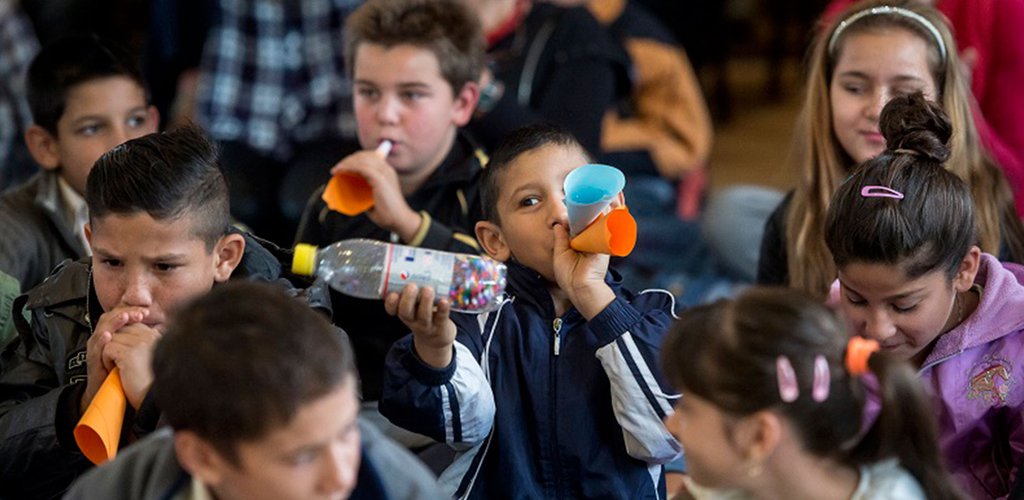“I spent my whole life hoeing the ground. I didn’t even know something like this existed. It brought tears to my eyes.” This admission came from an elderly lady years ago at a nursing home in Veresegyháza after a community concert. Her response has left an indelible impression on the musicians who performed there. There’s no need for a more powerful or clearer message to demonstrate the power of music.
In order to demonstrate this power to kindergartners from a village lying hidden in a disadvantaged region with little cultural stimuli, or to a church community in Budapest, or to the residents of the Institute for the Blind or the Pető Institute, the musicians need to get close to local audiences.
And not just in a physical or geographical way, but also in terms of mentality and open-mindedness. Though it must be an incredible feeling to play at Carnegie Hall, the grand hall of Müpa Budapest, the Royal Albert Hall or the Musikverein in Vienna in front of a crowd of thousands, I’ve been told by many that nothing is more incredible than playing Leó Weiner’s Fox Dance against a backdrop of fields of rapeseed, or playing the violin at a school gym in Salgótarján wearing a clown hat.
It’s not easy to say which one tops everything. Because where else can it happen that a grand orchestra concert audience can become so intoxicated by the music that they climb onto the stage toward the tuba player, who dances them around? Where else could musicians sit down together with the audience after a concert to eat mutton stew? Where else could someone personally tell a musician their impressions after a concert? Where else could they have a chance to ask questions? Or to chat?
To quote conductor Gábor Takács-Nagy, “The music of Haydn and Mozart is warm and humane, with overwhelming positive vitality and a sense of love.” Which is exactly what the audience can experience when a concert or musical event brings them together: an incredible amount of positive energy forging audience and musicians into a community.
There are more and more good examples of this in Hungary. If we’re lucky, we can stumble upon a secretly or publicly organised home concert, where the community experience is further enhanced by intimacy and coziness. The summer series “Auntie Ilonka’s Corridor Concert” on Lovag utca was one such gem, where everyone was welcome, whether they came in from the street or the same building. The organisers described the purpose of the concert as “creating a tiny break in people’s busy routines for them to be able to relax on the corridor and lose themselves in the music”. While listening to the Four Bones Quartet, we could discuss with our neighbour how big our grandkids were and what feats they were currently capable of. This is when the most beautiful, human and random encounters can occur with those people who were looking for the same thing that evening.
It wasn’t Anna and Gergő’s first time playing music at their home on Szalag utca this spring. As for why they let even strangers into their living room, they simply love making music and want to share this passion with others. Listening to musicians play in their own living spaces, surrounded by their favourite personal items, photos and books has a unique appeal. Both listener and musician feel at home, sitting on the floor in socked feet, relaxed.
Each year, Budapest Bár chooses a cause to support. This year it picked the Festival Orchestra’s Dancing on the Square project. The programme culminates when hundreds of Roma and non-Roma, disadvantaged and more fortunate children, dance to live music together in the heart of Budapest in front of thousands. Though the majority of the young participants have never visited Budapest, never seen an instrument from close up or never before listened to classical music, on that day they create something big and uplifting together. The orchestra even organised an adventure camp for the children, where they were presented with a real community concert by Budapest Bár. The band was swept off its feet by the enthusiasm and energy of the youngsters, and felt they had gotten far more on this remote island in Hollókő than at a regular concert.
The most fundamental method of making community music is perhaps singing. Listening to large crowds singing together on the street a song specifically composed for this occasion, the finale to the Night of the Choirs, is an experience that is guaranteed to give you goose bumps.
The physical and spiritual closeness, the immediacy, and the personal encounters are why this type of music comes with even greater responsibility for musicians than playing music on the stage in the spotlight. Because afterwards, the children bombard them with questions, and the music brings back many memories that elderly people want to share or process, and because community music can help ease loneliness, lethargy, pain and apathy. At these times, musicians selflessly give everything they have. And they get a great deal back in return.
The author is the PR manager of the Budapest Festival Orchestra.
Guest authors are external experts and not members of the Forbes editorial team and their views do not necessarily reflect those of Forbes.
